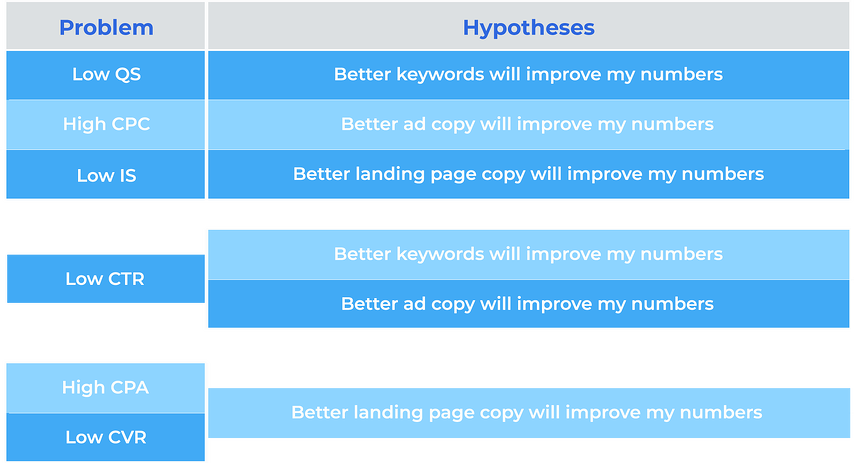Multifamily SEM Campaign Optimization

In our last article, we looked at some of the basics of multifamily search engine marketing (SEM). At the close of that article, we mentioned that SEM is both an art and science. Having spent time on the art of writing copy and satisfying search intent, now we need to look at the science of placing and optimizing ads for maximum return on investment (ROI).
The Science of Search Engine Marketing: Some Preliminaries
There’s a basic principle in science that states: your object determines your method. What does that mean? Well, if you want to find the weight of a boulder, you don’t use a telescope; you use a scale.
In SEM, your basic tools include Adwords’ built-in console working along with Google Analytics. There are other options out there, but for our purposes, we’ll focus on those. Knowing what tool to use isn’t enough, of course. You need to know what it’s for before you can learn how to use it.
In other words, your first step is to specify what you want to accomplish with this campaign. Here are a few common SEM goals for multifamily property managers:
- Market Positioning/ Presence – Possibly the most important on the list; prospects need to find YOU when they are searching for a new apartment. 70% of apartment seekers are beginning their search online which means that you need to be there when they hit Google search. If not, your competition will fill the gap and capture initial lead traffic.
- Web Traffic – Simply put, you want more eyeballs on your site. Nothing more.
- Community Tours – You want interested prospects to get excited about your community and book a tour.
As we’ll see soon enough, the goals you set for your website will not only determine the key performance indicators (KPIs) you focus on but the specific action you’ll take as you seek to dial in your SEM campaign.
Show Me the Numbers: 6 KPIs for Multifamily SEM
The Adwords console is a robust and (mostly) user-friendly resource for dissecting each campaign by the numbers. Before you can make sense of it, though, we need to spell out some of the most important metrics you’ll find in connection with any SEM platform.
1. Quality Score (QS)
According to Google, Quality Score is “an estimate of the quality of your ads, keywords, and landing pages.” High-quality ads cost less and place higher on search results pages. The burning question: how do I increase Quality Score? The short answer: see our last post. Quality Score is a function of your ad’s relevance to searchers. If you write a compelling ad that points searchers to a high-converting landing page, Google will count that towards quality.
To find your Quality Score for a particular ad or ad group, click the ‘Keywords’ tab in Adwords and mouse over that ad’s status on the spreadsheet that pops up.
2. Impression Share (IS)
An impression is whenever your ad shows up, regardless of whether a visitor clicks through. Cost per mille (CPM) shows how much you’ve paid for every 1,000 impressions. While it’s helpful to know how many times your ads are appearing, a better measurement is impression share (IS). IS shows how much your ad has appeared vs. how many times it could have appeared. To increase IS, improve your ad quality (see #1 above). Once your Quality Score is healthy, you can ramp up your maximum bid amount to ensure you’re keeping up with the competition. Many awareness campaigns are designed specifically to maximize impressions and for that duration, blindly outbidding the market will also ensure placement.
3. Click-Through Rate (CTR)
Clicks are the life’s blood of any SEM campaign. If people aren’t clicking your ads, then nothing else really matters. Still, clicks aren’t enough of a diagnostic tool. You’ll need more information to diagnose the health of your SEM campaign. That’s where CTR comes in. CTR is your ad’s ratio of clicks to appearances. So, if your ad showed up 100 times and 3 people clicked on it, your CTR would be 3%. CTR is best measured in context. Each industry has its own benchmark. According to Google, the average CTR for real estate is right around 3.7%. That’s a good place to start, but local market factors will always exert influence on your CTR.
Benchmarks are only a starting point. Optimization is about measurement and action (see below). Keep close tabs on your CTR as you make adjustments to your ad copy. If it goes up, you’re on the right track.
4. Cost Per Click (CPC)
Simple enough, CPC is the average amount you pay for each click. As with CTR, context matters. CPC depends on the industry and what competitors are willing to pay for traffic. High-value industries (e.g., lawyers) will spend as much as $6 for a single click. That’s because traffic is potentially worth a lot of money to them. The average CPC for real estate is $1.81 per click. If you’re higher, that doesn’t necessarily mean you’ve done something wrong. You might just be in a more expensive market, or you may be targeting high-value keywords (i.e., Manhattan luxury high rise).
As with CTR, you’ll need to track your own numbers and look for incremental improvement (a lower CPC). The best way to accomplish that improvement is to dial in your keyword targeting and optimize your ad/landing page copy (see below).
5. Conversion Rate (CVR)
CVR is a function of clicks to conversions. So, if 100 people click through your ad and 3 people sign up for a tour, your conversion rate would be 3%. Unlike market- and industry-determined variables like CTR and CPC, you get to exercise significantly more control over conversion rates. How? The answer to that question coincides with the question about improving Quality Score. Once a searcher clicks through your ad, it’s up to you to compel them to act. If you’ve dialed in your keyword targeting and ads, then that highly qualified SEM lead should convert. If it doesn’t, then either your ad copy, landing page, or keywords (or, all three!) need work.
What’s a “good” conversion rate? While you might be able to find some benchmark data, there is no objective answer. Instead, you need to monitor your conversion rates, make incremental changes (see below), and continue to make positive refinements.
6. Cost Per Acquisition (CPA)
CPA takes conversions and CPC into account. So, if you paid $2 per visitor and it took you 25 visitors for someone to sign up, that means you paid $50 for that acquisition. If you convert 50% of your in-person visitors, then that means you’re paying $100 per signed lease. Compared to your typical referral bonus, that’s not bad at all. If you want to reduce your CPA (which you do), then you’ll want to reduce CPC and/or increase CVR. Consider an optimized version of the example: if you paid $1.50 per visitor and it took you 20 visitors to secure a sign-up, that’d drop your CPA to $30. With a 50% in-person conversion rate, that means you’re paying $60 per newly signed lease.
Method Over Madness: A Scientific Way to Optimize Multifamily SEM
With the above KPIs in hand, odds are you’ve already intuited how to move forward. Is your CTR too low? Choose better keywords! Is your CPA too high? Write better copy!
Simple, right? Well, not so fast. First of all, remember what we said about goals above. If your object determines your method, then your objectives determine which levers you’re going to pull to optimize your SEM campaign.
- Traffic (Awareness) – CPM and CTR are your bread and butter.
- Conversion (Leases Signed) – Clicks matter but low CPC & CPA are paramount.
Whatever your goal, attention to analytics puts the optimization ball decisively in your court. Instead of guessing whether your ads are working, you can know what you’re paying for each converted web lead. From that point, you’ve got options:
1. Decide whether or not a conversion is worth what you’re paying (CPA).
2. Delete campaigns that aren’t worth their ad spend.
3. Devise smart ways to optimize and amplify the ads that are working.
For the rest of this article, we’re going to unpack #3 using our own modified version of the standard ‘scientific method’ in 6 steps.
1. Ask a Question
The scientist’s first step is to ask a relevant question based on his or her background knowledge. This one’s easy: How can I convert more prospects for less money?
2. Do Background Research
Assuming you’ve set up your campaign, everything you need is laid out for you in the Adwords console. If your campaign has been set up for some time, Google even makes it easy for you to access historical data so that you can track trends over time.
3. Construct a Hypothesis
We’ve hinted at this above in our description of each KPI. Now it’s time to put it into practice. Here are a few pre-fab hypotheses for you to consider:

As you can see, the options for optimization aren’t exactly vast. On top of that, “better” is a relative term that can only finally be determined through trial & error. If you find that your campaigns are stagnating, it is always good to answer the basic question of, “What is the person searching this term, hoping to find?”
4. Test Your Hypothesis
Here’s where things get interesting. Because there are often multiple factors in play, it’s important to make incremental changes and then watch for improvement. Don’t change more than one element at a time. When it comes to keyword targeting and ad copy, you can implement your changes by creating multiple Ad Groups. Divvy up your budget accordingly and monitor each group closely to see which changes net the best improvement in your relevant KPIs.
For landing pages, Google Content Experiments is a helpful tool for creating multiple variants (different page layouts, alternate versions of copy, various colors, etc.) and testing them alongside one another. Consider this A/B testing on steroids.
5. Analyze the Data
Make your changes and then give your numbers time to respond. If you see promising movement on one or more KPIs, increase your budget for that particular variant and watch whether the numbers continue to trend in a positive direction.
6. Report and Repeat
It’s important you keep clear records not only as “proof” for your relative stakeholders but as a benchmark for measuring future success. SEM optimization is an ongoing process. There’s always something you can do to fine-tune your campaigns. At first, SEM optimization may seem like an unwieldy drag on your time. Stick with it! After a few weeks of learning your way around the platform, along with the help of the right tools, you can manage your entire SEM profile in as little as 20 minutes a week.
Conclusion
As we’ve seen, search engine marketing is both an art and a science. Ultimately, your words and site design (art) will either compel or repel potential renters. Even so, with the right attention to data (science), you don’t have to guess about whether your words are working or not. Instead, you can tweak and refine until you’ve got an SEM campaign that brings in steady revenue for your multifamily community.


